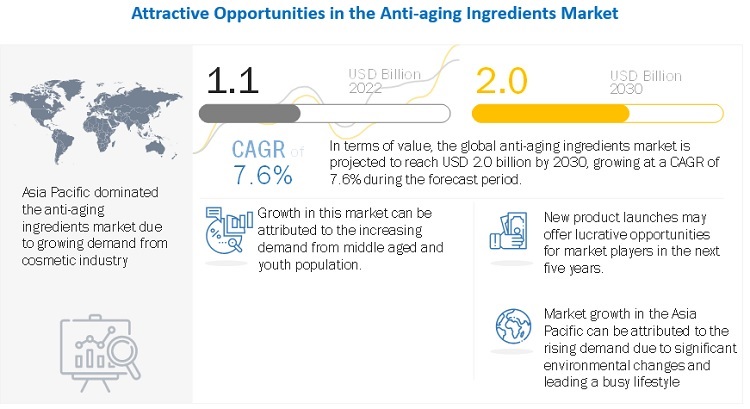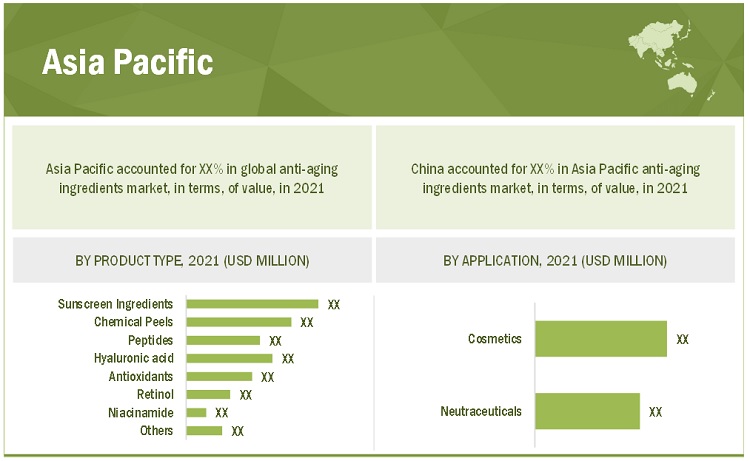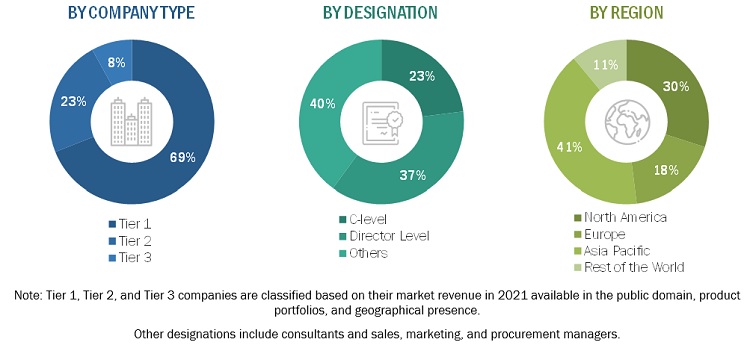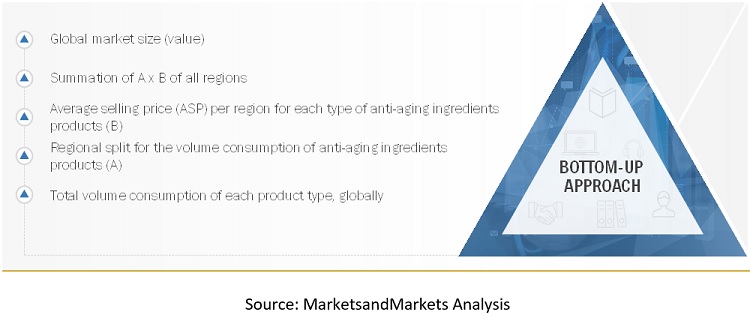Anti-aging Ingredients Market by Product Type (Chemical Peels, Sunscreen Ingredients, Peptides, Hyaluronic Acid, Antioxidants, Retinol, and Niacinamide), Application (Cosmetics and Nutraceuticals), and Region - Global Forecast to 2030
The anti-aging ingredients market is projected to reach USD 2.0 billion by 2030, at a CAGR of 7.6% from USD 1.1 billion in 2022. Anti-aging ingredients are cosmeceutical skincare ingredients that hydrate the skin and protect it from sun exposure to reduce, mask, or prevent the appearance of skin aging. Traditional moisturizing ingredients, such as peptides, hydroxy acid, hyaluronic acid, retinoic acid, retinol, and antioxidants, are among the many anti-aging ingredients that slow down the aging process by working against sun exposure & heredity factors and providing hydration. Anti-aging products, in general, contain high concentrations of carotenoids, antioxidants, flavonols, isoflavones, leucine, nitrates, vitamin C, vitamin E, and other nutrients that slow the aging process.

To know about the assumptions considered for the study, Request for Free Sample Report
Market Dynamics
Driver: Gradual shift in consumer preference towards antiaging products
The widespread availability of at-home anti-aging ingredients t for wrinkle reduction, skin rejuvenation, cellulite reduction, and microdermabrasion has led to an increase in customer interest. Furthermore, these products are scientifically advanced and portable. The popularity of at-home anti-aging ingredients solutions is on the rise globally, with adults seeking ways to retain their young appearance and the elderly focusing on measures to keep the indications of ageing at check.
Restraints: High cost of production to hinder the market growth
The doctors and healthcare providers treat people with various type of processes and treatments against anti-aging. The anti-aging treatments such as hair restoration, anti-pigmentation, adult acne therapy, breast augmentation, liposuction, and chemical peel are quite expensive in nature. These types of anti-aging treatments use different types of devices such as laser aesthetic devices, microdermabrasion devices, and radio frequency devices.
Opportunities: Rising investments and adoption in cosmetic industry
People have started investing in anti-aging products to look young. Women are more likely to opt for anti-aging products. Rise in such trends is creating value-grab opportunities for companies and manufacturers operating in the anti-aging ingredients market. Increasing disposable income, popularity of anti-aging products, skin rejuvenation & resurfacing treatments, growing geriatric population, and rising in number of skin problems are some of the factors boosting the anti-aging ingredients market in the global market.
Challenges: Side effects rising from the products to pose as a challenge
As customers want organic and natural skincare products, the popularity of chemical-based anti-aging and anti-wrinkle treatments is expected to decline. This is due to a number of incidents in which the negative consequences of these items have been revealed. These products may cause reactions ranging from moderate irritation to allergic contact dermatitis in people who are sensitive to them.
“The sunscreen ingredients segment accounted the largest of anti-aging ingredients market in 2021, in terms of value”
The increasing consumption of skincare products owing to climate change is estimated to create profitable opportunities for the sunscreen ingredients. Based on dynamic climatic conditions and personal skin types, the introduction of UV filter-based products by manufacturers will propel the sunscreen ingredient demand. Moreover, the growing awareness regarding the importance of sun protection and the development of skin cancer & diseases due to ozone layer depletion are driving the sunscreen ingredients segment expansion.
“The cosmetics segment accounted for the largest application for Anti-aging ingredients market in 2021, in terms of value”
The growing awareness of one's physical appearance among both young & old consumers has fueled the demand for cosmetics & anti-aging products, thereby driving the market globally. A good physical personality is a requirement that determines an individual's success in various areas of life, thereby augmenting the use of anti-aging products that can limit or delay these changes. Furthermore, the rapidly increasing youth population and increasing disposable incomes worldwide have led to the increasing demand for cosmetics, thereby driving the overall industry statistic.
“Asia Pacific was the largest market for Anti-aging ingredients in 2021, in terms of value.”
Growth in the Asia Pacific region is due to increasing disposable incomes and shifting consumer lifestyles. The increasing number of online retail platforms and rising health & fitness awareness are likely to create more business opportunities. Increasing focus on corporate life and rising awareness of men's grooming, specifically among the youth, are projected to boost the demand for cosmetics products, thereby driving the demand for anti-aging ingredients in this region.

To know about the assumptions considered for the study, download the pdf brochure
Key Market Players
The key players in this market are Adeka Corporation (Japan), Contipro Inc. (Czech Republic), Beiersdorf AG (Germany), BioThrive Sciences (US), Kao Corporation (Japan), and SHISEIDO (Japan). Continuous developments in the market—including new product launches, mergers & acquisitions, agreements, and expansions—are expected to help the market grow. Leading manufacturers of anti-aging ingredients market have opted for new product launches to sustain their market position.
Scope of the Report
|
Report Metric |
Details |
|
Years considered for the study |
2017-2030 |
|
Base Year |
2021 |
|
Forecast period |
2022–2030 |
|
Units considered |
Volume (Kiloton); Value (USD Million) |
|
Segments |
Product Type, Application, and Region |
|
Regions |
Asia Pacific, North America, Europe, Middle East & Africa, and South America |
|
Companies |
The key players in this market are Adeka Corporation (Japan), Contipro Inc. (Czech Republic), Beiersdorf AG (Germany), BioThrive Sciences (US), Kao Corporation (Japan), and SHISEIDO (Japan). |
This report categorizes the global Anti-aging ingredients market based on product type, distribution channel, and region.
On the basis of product type, the Anti-aging ingredients market has been segmented as follows:
- Chemical Peels
- Sunscreen Ingredients
- Peptides
- Hyaluronic Acid
- Antioxidants
- Retinol
- Niacinamide
- Others
On the basis of application, the Anti-aging ingredients market has been segmented as follows:
- Introduction
- Cosmetics
- Nutraceuticals
- Others
On the basis of region, the Anti-aging ingredients market has been segmented as follows:
- Asia Pacific
- Europe
- North America
- Middle East & Africa
- South America
Frequently Asked Questions (FAQ):
What is the expected growth rate of Anti-aging ingredients market?
The Anti-aging ingredients market is projected to reach USD 2.0 billion by 2030, at a CAGR of 7.6% from USD 1.1 billion in 2022
Who are the major key players in Anti-aging ingredients market?
Adeka Corporation (Japan), Contipro Inc. (Czech Republic), Beiersdorf AG (Germany), BioThrive Sciences (US), Kao Corporation (Japan), and SHISEIDO (Japan).
What is the average selling price trend for Anti-aging ingredients market?
Prices are low in Asian countries (primarily China and India) compared to those in Europe and North America due to the low prices of raw materials and the availability of low-cost workforces in Asia Pacific. .
To speak to our analyst for a discussion on the above findings, click Speak to Analyst

Table of content
1 Introduction
1.1 Objective of the study
1.2 Market definition
1.3 Market Scope
1.3.1 Years considered for the study
1.4 Currency
1.5 Unit Considered
1.6 Stakeholders
2 Research Methodology
2.1 Research Data
2.2 Secondary Data
2.2.1 Key data from secondary sources
2.3 Primary Data
2.3.1 Key data from primary sources
2.3.2 Breakdown of Primary Interviews
2.4 Market Size Estimation
2.4.1 Bottom-Up Approach
2.4.2 Top-Down Approach
2.5 Data Triangulation
2.6 Assumptions
2.7 Limitations
3 Executive Summary
4 Premium Insights
4.1 Opportunities in Anti-aging Ingredients Market
4.2 Anti-aging Ingredients Market, By Product Type
4.3 Anti-aging Ingredients Market, By Application
4.4 Anti-aging Ingredients Market, By Region
5 Market Overview and Industry Trends
5.1 Introduction
5.2 Market Dynamics
5.2.1 Drivers
5.2.2 Restraints
5.2.3 Opportunities
5.2.4 Challenges
5.3 Supply Chain Analysis
5.3.1 Raw Material
5.3.2 Manufacturers
5.3.3 Distribution
5.3.4 End-Use Industry
5.4 Porter’s Five Forces Analysis
5.4.1 Threat of New Entrants
5.4.2 Threat of Substitutes
5.4.3 Bargaining Power of Buyers
5.4.4 Bargaining Power of Suppliers
5.4.5 Intensity of Competitive Rivalry
5.5 Average Selling Price
5.6 Regulatory Landscape
5.7 Industry Outlook
6 Anti-aging Ingredients Market, By Product type
6.1 Introduction
6.2 Chemical Peels
6.3 Sunscreen Ingredients
6.4 Peptides
6.5 Hyaluronic Acid
6.6 Antioxidants
6.7 Retinol
6.8 Niacinamide
6.9 Others
7 Anti-aging Ingredients Market, By Application
7.1 Introduction
7.2 Cosmetics
7.3 Nutraceuticals
7.4 Others
8 Anti-aging Ingredients Market, By Region
8.1 Introduction
8.2 Asia Pacific
8.2.1 China
8.2.2 India
8.2.3 Japan
8.2.4 South Korea
8.2.5 Rest of Asia Pacific
8.3 North America
8.3.1 U.S.
8.3.2 Canada
8.3.3 Mexico
8.4 Europe
8.4.1 Germany
8.4.2 France
8.4.3 Italy
8.4.4 U.K.
8.4.5 Spain
8.4.6 Russia
8.4.7 Belgium
8.4.8 Rest of Europe
8.5 Middle East & Africa
8.5.1 UAE
8.5.2 Saudi Arabia
8.5.3 South Africa
8.5.4 Rest of Middle East & Africa
8.6 South America
8.6.1 Brazil
8.6.2 Argentina
8.6.3 Rest of South America
9 Competitive Landscape
9.1 Introduction
9.2 Market Share Analysis
9.3 Company Evaulation Quadrant
9.4 Competitive Situation & Trends
9.4.1 New Product Launches
9.4.2 Contracts & Agreements
9.4.3 Partnerships & Collaborations
9.4.4 Joint Ventures
9.4.5 Expansions
10 Company Profile
10.1 Adeka Corporation
10.1.1 Business Overview
10.1.2 Products Offered
10.1.3 Recent Development
10.1.4 MnM View
10.1.4.1 Key Strengths
10.1.4.2 Strategic choices made
10.1.4.3 Threat from competition
10.2 Contipro Inc.
10.3 Beiersdorf AG
10.4 BioThrive Sciences
10.5 Kao Corporation
10.6 SHISEIDO
10.7 List of other key market players
11 Appendix
11.1 Insights from Industry Experts
11.2 Discussion Guide
11.3 Related Reports
The study involved four major activities to estimate the size of anti-aging ingredients market. Exhaustive secondary research was done to collect information on the market, the peer market, and the parent market. The next step was to validate these findings, assumptions, and sizing with industry experts across the value chain through primary research. Both top-down and bottom-up approaches were employed to estimate the complete market size. Thereafter, the market breakdown and data triangulation procedures were used to estimate the market size of the segments and subsegments.
Secondary Research
In the secondary research process, various secondary sources have been referred to for identifying and collecting information for this study. These secondary sources include annual reports, press releases, investor presentations of companies, white papers, certified publications, trade directories, certified publications, articles from recognized authors, gold standard and silver standard websites, and databases.
Secondary research has been used to obtain key information about the value chain of the industry, monetary chain of the market, the total pool of key players, market classification and segmentation according to industry trends to the bottom-most level, and regional markets. It was also used to obtain information about the key developments from a market-oriented perspective.
Primary Research
The anti-aging ingredients market comprises several stakeholders in the value chain, which include raw material suppliers, manufacturers, distributors, and end users. Various primary sources from the supply and demand sides of the anti-aging ingredients market have been interviewed to obtain qualitative and quantitative information.
The primary interviewees from the demand side include key opinion leaders in end-use sectors. The primary sources from the supply side include manufacturers, associations, and institutions involved in the cosmetic industry.
The breakdown of profiles of the primary interviewees is illustrated in the figure below:

To know about the assumptions considered for the study, download the pdf brochure
Market Size Estimation
The top-down and bottom-up approaches have been used to estimate and validate the size of the anti-aging ingredients market.
- The key players in the industry have been identified through extensive secondary research.
- The supply chain of the industry has been determined through primary and secondary research.
- All percentage shares, splits, and breakdowns have been determined using secondary sources and verified through primary sources.
- All possible parameters that affect the markets covered in this research study have been accounted for, viewed in extensive detail, verified through primary research, and analyzed to obtain the final quantitative and qualitative data.
- The research includes the study of reports, reviews, and newsletters of the key market players, along with extensive interviews for opinions with leaders such as directors and marketing executives.
Anti-Aging Ingredients Market: Bottom-Up Approach 1

To know about the assumptions considered for the study, Request for Free Sample Report
Data Triangulation
After arriving at the total market size from the estimation process explained above, the overall market has been split into several segments and sub-segments. To complete the overall market engineering process and arrive at the exact statistics for all the segments and sub-segments, the data triangulation and market breakdown procedures have been employed, wherever applicable. The data has been triangulated by studying various factors and trends from both the demand and supply sides. Along with this, the market size has been validated by using both the top-down and bottom-up approaches and primary interviews. Hence, for every data segment, there have been three sources—top-down approach, bottom-up approach, and expert interviews. The data was assumed correct when the values arrived from the three sources matched.
Report Objectives
- To define, describe, and forecast the size of the Anti-aging ingredients market, in terms of value and volume
- To provide detailed information regarding the major factors (drivers, opportunities, restraints, and challenges) influencing the growth of the market
- To estimate and forecast the market size based on product type and application
- To forecast the size of the market with respect to major regions, namely, Europe, North America, Asia Pacific, and Middle East & Africa, and South America along with their key countries
- To strategically analyze micromarkets1 with respect to individual growth trends, prospects, and their contribution to the overall market
- To analyze opportunities in the market for stakeholders and provide a competitive landscape of market leaders
- To track and analyze recent developments such as expansions, new product launches, partnerships & agreements, and acquisitions in the market
- To strategically profile key market players and comprehensively analyze their core competencies2
Available Customizations
Along with the given market data, MarketsandMarkets offers customizations according to the company’s specific needs. The following customization options are available for the report:
- Regional Analysis
Further breakdown of a region with respect to a particular country or additional application
- Company Information
Detailed analysis and profiles of additional market players















Growth opportunities and latent adjacency in Anti-aging Ingredients Market